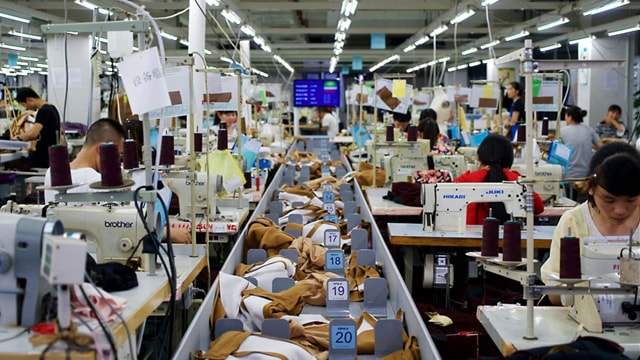In 2024, Vietnam’s garment-textile export value reached approximately $44 billion, marking an 11% increase from the previous year is a major economic driver. However, rising global competition, escalating labor costs, and production inefficiencies are significant challenges. Lean manufacturing, a strategy focused on reducing waste and boosting efficiency, presents the solution to transforming the industry. This article delves into how lean practices can tackle these challenges, optimize productivity, and drive sustainable growth in Vietnam’s apparel factories.
Introduction
The apparel industry is a key export sector in Vietnam, crucial to the country’s economic growth. With a skilled workforce and growing production capacity, the sector faces mounting pressure to remain competitive globally. Implementing lean manufacturing aims to improve efficiency, reduce waste, and optimize production processes, positioning factories for long-term success. This article explores how lean practices can be applied in Vietnam’s apparel industry, featuring industry data, case studies, and expert insights on practical applications and performance outcomes.
Current State of Productivity and Challenges in Apparel Manufacturing
Many Vietnamese apparel factories suffer from production bottlenecks, particularly in cutting, sewing, and finishing operations. These inefficiencies result in delays and increased costs. While the workforce is skilled, there are often gaps in training, particularly in lean principles. Furthermore, capacity constraints and outdated machinery hinder the potential for growth.
Excess waste in fabric and high energy consumption are prevalent, making the need for lean practices even more pressing. Lean manufacturing not only cuts costs but also enhances environmental sustainability by minimizing waste.
Core Principles of Lean Manufacturing
Lean manufacturing aims to deliver high-quality products with minimal waste. In the apparel industry, this means optimizing processes from fabric cutting to final delivery, ensuring that resources are used efficiently, and customer needs are met.
Focus on what matters to customers—quality, cost, and timely delivery. Analyze each step of the production process to identify and eliminate non-value-adding activities. Ensure that work flows smoothly with minimal interruptions or delays. Produce based on actual demand rather than forecasts to reduce excess inventory. Continuously improve processes to eliminate waste and improve efficiency.
Key Lean Tools and Techniques for Apparel Factories
Value Stream Mapping– Value stream mapping visualizes the entire production process, allowing factories to identify inefficiencies and areas of waste. This tool helps streamline operations by eliminating non-essential steps.
5S for Workplace Organization- The 5S methodology—Sort, Set in Order, Shine, Standardize, Sustain—improves workplace organization, reducing time spent searching for tools and materials, and promoting cleanliness and order.
Kaizen (Continuous Improvement)- Kaizen focuses on small, incremental changes that improve efficiency over time. In apparel manufacturing, this can mean refining cutting techniques, improving machine setups, or reducing handling times.
Just-in-Time (JIT) Production– JIT production ensures that materials arrive just in time for production, reducing excess inventory and storage costs. This approach leads to a more agile and efficient supply chain.
Kanban for Demand-Driven Production Control- Kanban uses visual signals to control inventory and production flow. By aligning production with actual customer demand, it reduces the risk of overproduction and excess stock.

The integration of advanced technological and automation solutions has played a key role in boosting workplace productivity.
Successful lean adoption starts with strong leadership. Executives must champion the transformation, set clear goals, and allocate resources. Employee training is crucial, ensuring workers understand lean principles like 5S and Kaizen. Optimizing production areas such as cutting, sewing, and finishing reduces lead times and improves quality. Streamlining these processes enhances throughput and minimizes delays. Standardizing procedures and reducing machine setup times increase efficiency, while smaller, more frequent batches and less downtime improve flexibility and shorten lead times.
- Addressing Common Sources of Waste in Apparel Production
Overproduction is a major waste in apparel manufacturing. Lean tools like JIT and Kanban control inventory and align production with demand. Defects and rework increase costs, but lean emphasizes error prevention and quality control, leading to fewer mistakes and higher-quality products. Inefficient factory layouts cause unnecessary motion and transport; redesigning workflows and placing materials closer to production lines saves time and reduces errors. Lean practices eliminate delays by streamlining workflows and improving communication, resulting in faster production and delivery.
- Case Studies and Practical Applications
Several Vietnamese apparel factories have successfully implemented lean techniques. One factory reduced its lead time by 20% and cut costs by 15% through JIT production and value stream mapping. Quality improvements were also evident, with fewer defects and less rework.
- Technology Integration with Lean Manufacturing
Automation can further enhance lean manufacturing by reducing human error and improving production speed. Smart technologies, such as IoT sensors, enable real-time monitoring and process optimization. Digital tools provide valuable data for decision-making. By tracking key metrics like cycle times and defect rates, factories can make data-driven improvements in real time.
- Sustainability and Lean Manufacturing
Lean practices align with sustainability by reducing waste and improving resource efficiency. Less fabric waste and energy consumption make the production process more environmentally friendly. By combining lean principles with green initiatives, apparel factories can reduce their environmental footprint while improving operational efficiency.
- Conclusion and Future Outlook
Lean manufacturing offers significant opportunities to enhance productivity in Vietnam’s apparel factories. By adopting lean principles, the sector can reduce waste, improve quality, and become more competitive globally. With a strong commitment to leadership, workforce training, and technology integration, lean manufacturing can transform the future of Vietnam’s apparel industry, ensuring sustainable growth and improved profitability.

Divya Mohan
General Manager (International Business)
divyamohan@groyyo.com


Leave a Comment